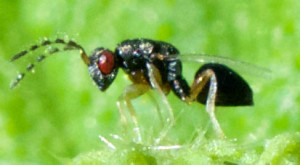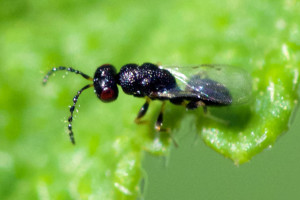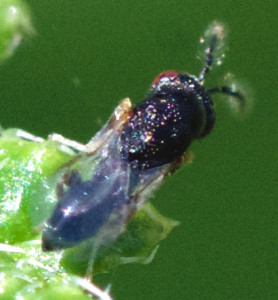Lately I’ve been getting photobombed. In several butterfly snaps (see this post here), I’ve seen these teeny tiny flying insects in the order hymenoptera showing up. Because they’re so small and I’ve never focused on them before, I just assumed that they were all the tiny bees that I recently got a positive ID on (Lasioglossum lepidii). So today, since all the butterflies I saw in the yard were ones I’ve got hundreds of images of (how jaded we get!) I decided to turn my lens on these guys and try to get a shot of these tiny little critters.
And I’m glad I did, because, as with most everything else, paying attention to something new makes you learn something new. It turns out that these little wasps with their black bodies and red eyes are nothing like the little bees with the black bodies and hairy yellow legs that I saw the other day. These guys are not little bees but chalcid wasps, members of an enormous group of tiny, mostly parasitic wasps (some, apparently, are phytophagous (plant eaters) rather than parasites or parasitoids).1
Here are the best images I’ve managed to get so far; you can be sure I’ll get out back with a tripod to try to get some better shots soon:



I’m intrigued by the contrast of the dark body and the red eyes, the challenge of getting an image of such a tiny creature, and by the reported diversity of this group of insects.
Parasitoid biology reaches its most elaborate development in the Chalcidoidea. There are solitary and gregarious species; ectoparasitoids2 and endoparasitoids;3 primary, secondary and tertiary parasitoids;4 polyembryonic species;5 and species with planidial6 larvae.
Doesn’t that sounds like an interesting group of insects? Nevertheless, given how difficult they are to spot and to photograph, I doubt that I’ll do more than appreciate them aesthetically while marveling at their diversity and applauding their ability to photobomb my more photogenic critters!
References
Noyes, J. S. 2003. Universal Chalcidoidea Database. Natural History Museum, London. Available at http://www.nhm.ac.uk/research-curation/research/projects/chalcidoids/introduction.html.
Related Images:
- Parasites get their food from the host and perhaps weaken it or make it sick, but generally don’t kill it. Parasitoids, on the other hand, are fatal, usually gruesomely so, to their hosts.
- live on the outside of the host’s body
- live inside the host’s body
- recursive parasitoidism; think of Russian dolls
- two or more embryos develop from a single egg
- From Wikipedia: The function of the planidial stage is to find a host on which the larva may feed until it attains adulthood.

Thanks for helping me solve this….have several photos and your site helped me id